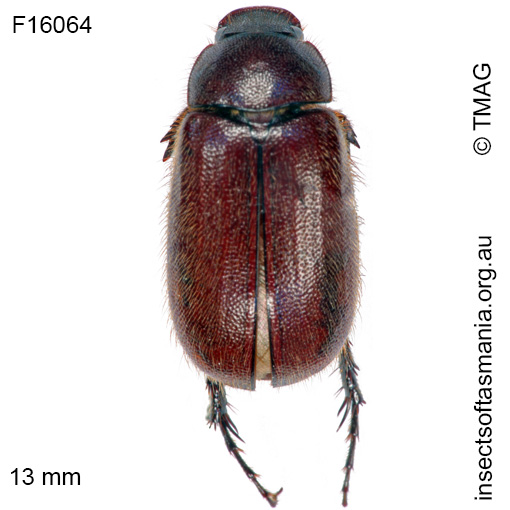
Heteronyx pubescens (a species of scarab-beetle)
Basis for Tasmanian occurrence
TMAG collections
Classification
Suborder: Polyphaga
Superfamily: Scarabaeoidea
Family: Scarabaeidae
Subfamily: Melolonthinae
Tribe: Heteronycini
Morphology
Flightedness: winged and assumed capable of flight
Source literature on morphology and taxonomy (*primary taxonomic source, where identified):
*Erichson, W.F. (1842). Beitrag zur Insecten-Fauna von Vandiemensland, mit besonderer Beruecksichtung der geographischen Verbreitung der Insecten. Nicolai’schen Buchhandlung 8(1): 379 pages.
Ecology
Association with dead wood or old trees: not saproxylic
Collection method(s) for TMAG material: — At light (with use of light-trap) — Baited trapping (funnel trap) — Flight intercept trapping (trough below Malaise trap) — Hand collection (substrate not specified) — Hand collection from Eucalyptus amygdalina — Hand collection from Eucalyptus nitens — Hand collection from Eucalyptus viminalis — Malaise trapping — Pipe trapping — Pitfall trapping — Trapping using a range of devices placed in crown of Eucalyptus obliqua (Bar-Ness, 2005) — Trunk window trapping (Harrison, 2007).
Source ecological literature:
Grove, S.J. (2009b). Beetles and fuelwood harvesting: a retrospective study from Tasmania’s southern forests. Tasforests 18: 77-99.
Baker, S.C. (2006b). Ecology and conservation of ground-dwelling beetles in managed wet eucalypt forest: edge and riparian effects. PhD thesis, Univ. of Tasmania, Hobart.
Bar-Ness, Y. (2005). Crown structure and the canopy arthropod biodiversity of 100 year old and old-growth Tasmanian Eucalyptus obliqua. Msc thesis, Univ. of Tasmania, Hobart.
Harrison, K.S. (2007). Saproxylic beetles associated with habitat features in Eucalyptus obliqua trees in the southern forests of Tasmania. PhD thesis, Dept. of Zoology, Univ. of Tasmania, Hobart.

